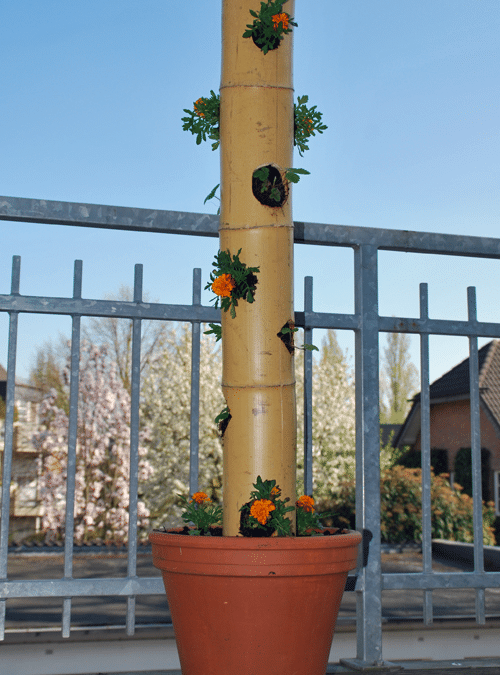First of all, we would like to thank all our readers for the great response to our first Salad Tree guide and the many comments, questions, hints, and notes. All this together was a great motivation for us to rethink the “Salad Tree” concept and redesign it in the Attensaat and cook drink love style.
For those who are not familiar with the first Salad Tree article: The Salad Tree was our first project on the topic of “Vertical Gardening”. It’s a great and creative method to practice urban gardening. With the upward growth, it saves a lot of space, which is not always available on a balcony or terrace. However, vertical gardening should also be sustainable. Plastic or synthetic tubes and all other PE, PP, or PVC-containing components are simply out of place.
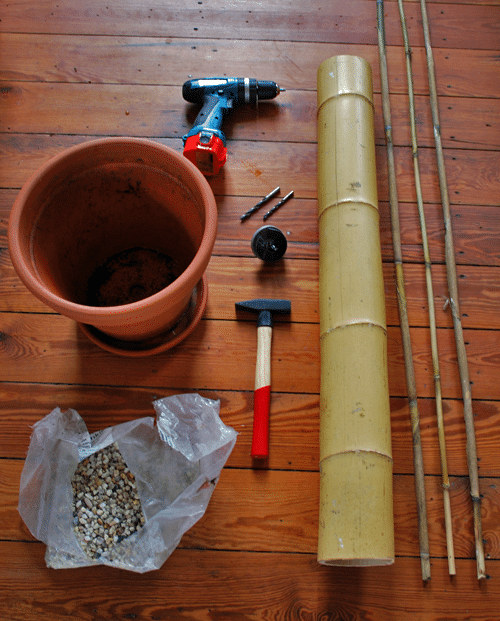
Sustainable Salad Tree – What you need…
So we thought about building an optimized version of the widely spread old Salad Tree on the internet with sustainable, plastic-free components. We needed an ecological alternative for the plastic tube, and the idea came relatively quickly: a tube made from renewable resources? Of course, bamboo! However, it took some time until we found an untreated bamboo tube of sufficient size. The bamboo tube has a diameter of 16 cm, is slightly longer than one meter, and comes from the terrarium trade.
Here is the complete list of all required materials:
- A bamboo tube with sufficient diameter and length (depending on planting)
- A large terracotta pot and saucer
- Gravel or other drainage material
- A drill with socket attachment or a jigsaw
- Larger wood drills (size 8 or 10)
- Thin bamboo sticks
- Potting soil and seedlings
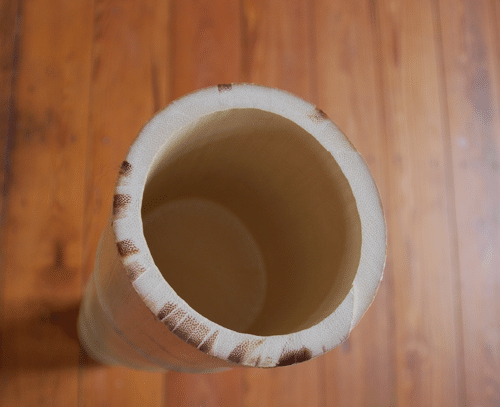
The bamboo tube for the Salad Tree from above
So let’s get to work. The first challenge for us was the individual internodes (stem sections) of the bamboo tube, as these segments are not completely hollow where they meet. To build a Salad Tree, the tube must be completely permeable to prevent waterlogging and allow water to flow freely. Therefore, we had to connect the individual segments together. However, the partitions in our bamboo tube were only 3-4 mm thick.

Bamboo tube with broken partitions
Breaking the wooden partitions in the bamboo tube was easier than expected. We simply took a suitable wooden slat and with the help of a hammer, broke the partitions and thus connected the individual segments into a continuous tube.

Round drill attachment for the drill
Next, we had to drill holes for the plants. What was quite uncomplicated with the old plastic tube variant and quickly done without much effort, turned out to be a bigger challenge, as we broke three of these attachments while trying to drill the holes.
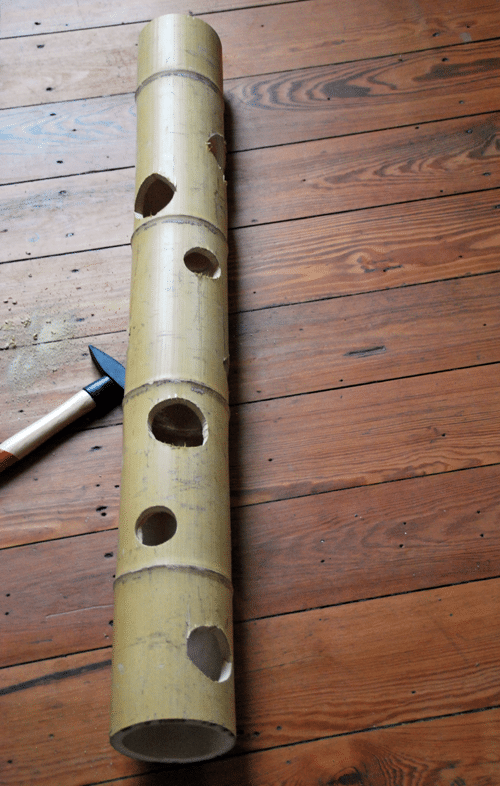
The bamboo tube on its way to becoming a Salad Tree
Eventually, we pre-drilled some holes with a normal wood drill and then used the jigsaw to cut round or less round holes.
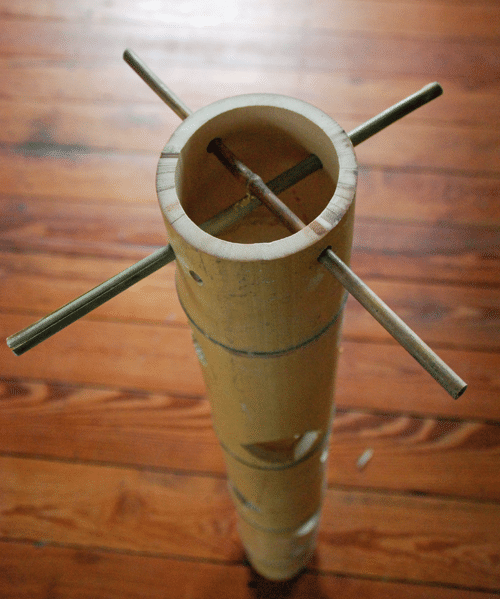
Making the Salad Tree more stable
Then we came up with another optimization, which you can see in the picture above. To make the Salad Tree more stable (as this proved problematic with the old model), we drilled four holes at the bottom of the bamboo tube, two of which are at the same height opposite each other. Through these, we then pulled one of the thin bamboo sticks. Afterward, we cut these to the necessary length (according to the planting container). The additional support should later keep the Salad Tree upright in the pot and prevent the construction from tipping over, or at least reduce the risk.

Terracotta pot with drainage layer
Next, we filled the terracotta pot with about five cm of gravel as a drainage layer.
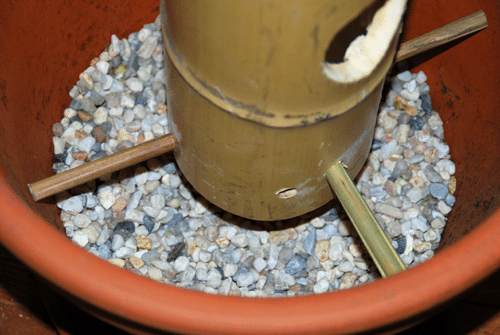
Salad Tree tube in the terracotta pot
Subsequently, the prepared bamboo tube is now placed in the terracotta pot. As you can see in the picture, the Salad Tree is now almost floating in the pot, as the bamboo sticks have wedged in it.
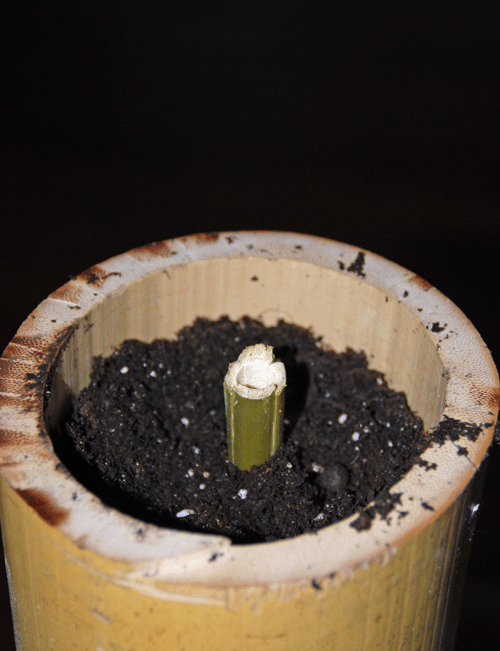
Salad Tree, already filled with soil and drainage pipe
Subsequently, the bamboo tube could finally be filled with soil. This is relatively simple. Of course, soil falls out here and there, but if this becomes too strenuous, you can plug the holes during filling with crumpled newspaper, for example.
Here’s another important detail: Unlike the old Salad Tree, we opted for a different irrigation option this time. Of course, the goal was to avoid plastics of any kind here too, so we used a thin bamboo tube. Since we had to break through the partitions of the individual segments again, we could only integrate a tube about 40 cm long into the interior of the Salad Tree. However, this seems almost optimal, as one of the main problems with the old Salad Tree was that the watering system did not work very well, as the water simply shot through to the bottom.
Now, with only a 40 cm long irrigation tube, we can simply water the upper half of the Salad Tree from above onto the soil and the lower half of the tree through the integrated bamboo tube, which then leads the water up to half the height of the tree and lets it seep away from there.
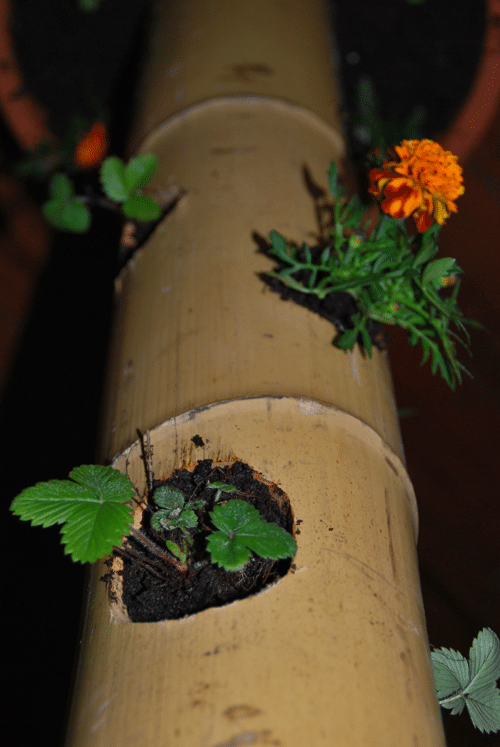
Mixed culture tree – planted with strawberries and marigolds
Subsequently, we planted the tree. But as you can easily see, this time we opted against lettuce and instead chose a mixed culture of strawberries and marigolds. A strawberry tree, so to speak.
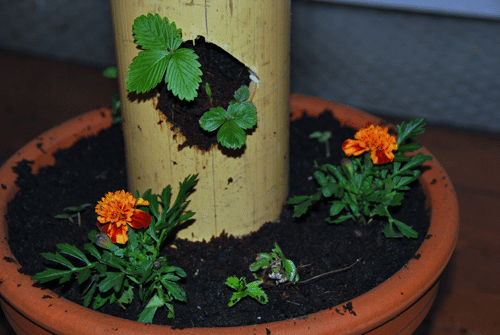
Strawberry tree with marigolds
In the pot, we also opted for a mixed culture of white monthly strawberries (Dreschflegel seed) and marigolds. We already sowed the white monthly strawberries last year. However, it was much too late, but the plants survived the winter well and are now sprouting again.
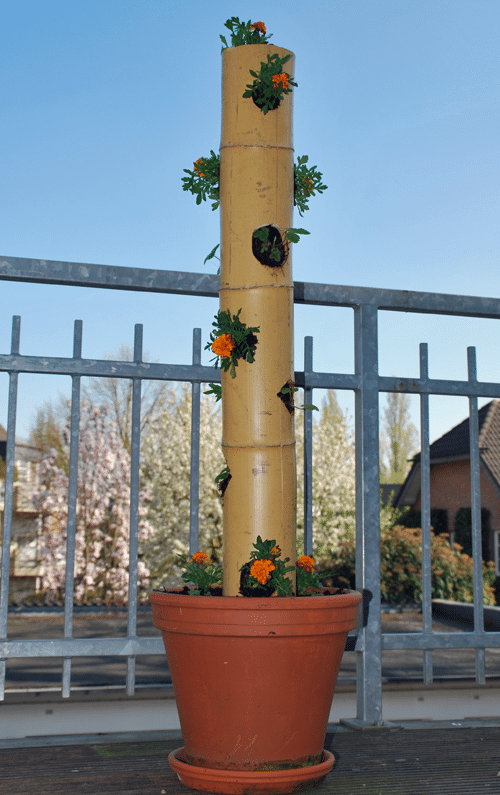
The fully planted strawberry tree made of a bamboo tube
Here’s another picture of the finished mixed culture tree. For the mixed culture of monthly strawberries and marigolds, we decided after reading On Good Neighbors: Mixed Cultures in the Garden. If you do not want to rely on the contradictory and incomplete online lists on the topic of “Good Neighbors in the Vegetable Bed”, this book is highly recommended. We devoured it. It is not only very affordable but also provides the background on why and how plants support or harm each other. We will also be relying entirely on mixed cultures for our vegetable planning on the balcony and even with the herbs on the kitchen window sill this year and are very excited about the success!
As always, we look forward to praise, criticism, comments, and especially suggestions for improvement. We wish you lots of fun building it! Do you have better ideas for planting? We are very curious about that too!

